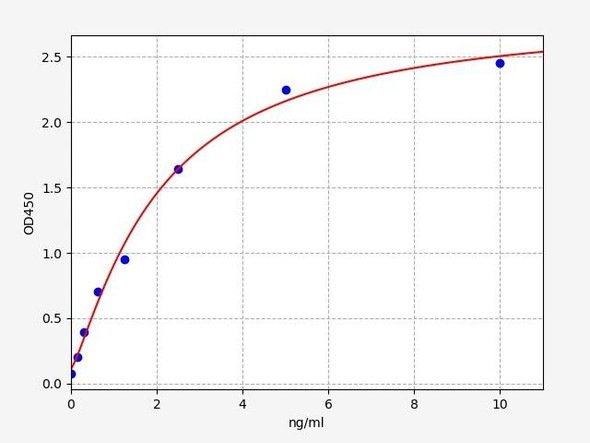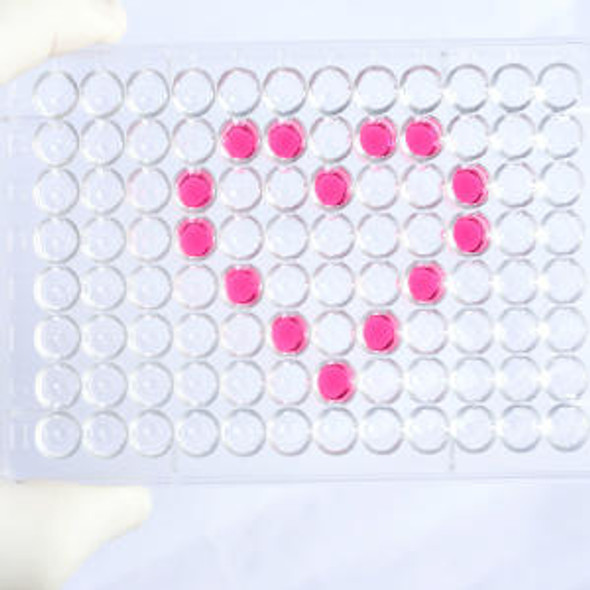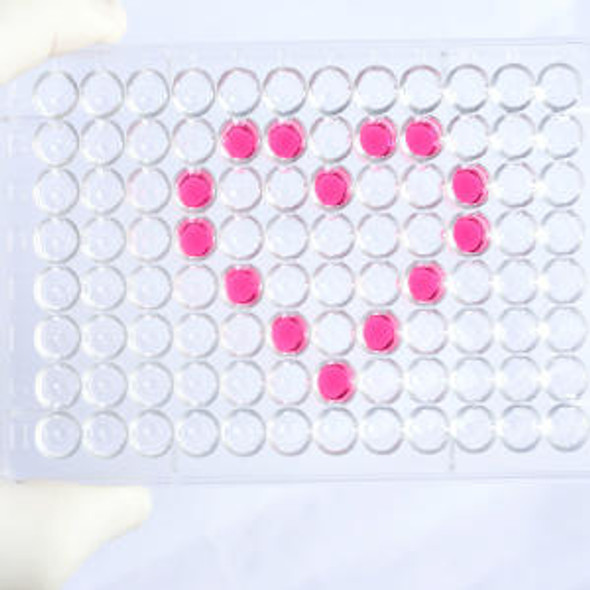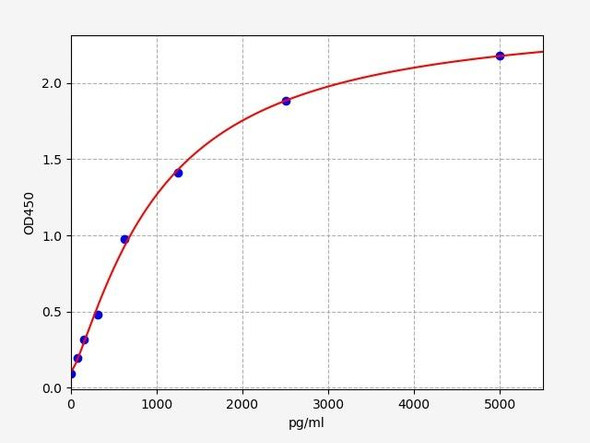Human Disks large homolog 4 (DLG4) ELISA Kit
- SKU:
- HUEB1294
- Product Type:
- ELISA Kit
- Size:
- 96 Assays
- Uniprot:
- P78352
- Range:
- 0.312-20 ng/mL
- ELISA Type:
- Sandwich
- Synonyms:
- DLG4, Disks large homolog 4, Postsynaptic density protein 95, PSD-95, Synapse-associated protein 90, SAP-90, SAP90
- Reactivity:
- Human
Description
| Product Name: | Human Disks large homolog 4 (DLG4) ELISA Kit |
| Product Code: | HUEB1294 |
| Alias: | Disks large homolog 4, Postsynaptic density protein 95, PSD-95, Synapse-associated protein 90, SAP-90, SAP90, DLG4, PSD95 |
| Uniprot: | P78352 |
| Reactivity: | Human |
| Range: | 0.312-20 ng/mL |
| Detection Method: | Sandwich |
| Size: | 96 Assay |
| Storage: | Please see kit components below for exact storage details |
| Note: | For research use only |
| UniProt Protein Function: | PSD-95: a membrane associated guanylate kinase (MAGUK) scaffolding protein located in neural postsynaptic densities. Associates with NMDA receptor NR2 subunits via glutamate serine (aspartate/glutamate) valine motifs in the cytoplasmic tail of NMDA receptor subunits and shaker-type potassium channels. Required for synaptic plasticity associated with NMDA receptor signaling. Its overexpression or depletion changes the ratio of excitatory to inhibitory synapses in hippocampal neurons. High levels in postsynaptic density of neurons in the forebrain. Also in presynaptic region of inhibitory synapses formed by cerebellar basket cells on axon hillocks of Purkinje cells. May reduce the amplitude of ACCN3 acid-evoked currents by retaining the channel intracellularly. Binds tissue-type plasminogen activator (tPA), mediating neural NMDA gating via a complex of LRP1, PSD-95 and NMDAR. Interacts through its first two PDZ domains with NMDAR2A, NMDAR2B, NMDAR2C, NMDAR2D, ACCN3, certain splice forms of NMDAR1, KV4.2, CXADR and synGAP. Interacts through its first two PDZ domains with Kv1.1, Kv1.2, Kv1.3, Kv1.4 and HER4. Interacts through its first PDZ domain with GluR6 and Kv1.4. Interacts through its second PDZ domain with the PDZ domain of nNOS or the C-terminus of NOS1AP. May interact with 5-HT(2A). Interacts through its third PDZ domain with NLGN1, and probably with NLGN2 and NLGN3. Interacts through its guanylate kinase-like domain with SAPAP1, SAPAP2, SAPAP3, SAPAP4, MAP1A, and BEGAIN. Interacts through its guanylate kinase-like domain with KIF13B. Two alternatively spliced human isoforms have been reported. Palmitoylation of isoform 1 is required for targeting to postsynaptic density. |
| UniProt Protein Details: | Protein type:Adaptor/scaffold Chromosomal Location of Human Ortholog: 17p13.1 Cellular Component: cortical cytoskeleton; dendrite cytoplasm; voltage-gated potassium channel complex; basolateral plasma membrane; endoplasmic reticulum; postsynaptic density; dendritic spine; excitatory synapse; postsynaptic membrane; synaptic vesicle; extrinsic to internal side of plasma membrane; cytoplasm; plasma membrane; ionotropic glutamate receptor complex; synapse; cell junction Molecular Function:P2Y1 nucleotide receptor binding; protein C-terminus binding; guanylate kinase activity; ionotropic glutamate receptor binding; protein binding; beta-1 adrenergic receptor binding; acetylcholine receptor binding; protein complex binding; D1 dopamine receptor binding; protein phosphatase binding; PDZ domain binding Biological Process: regulation of long-term neuronal synaptic plasticity; axon guidance; nervous system development; synaptic vesicle maturation; social behavior; learning; signal transduction; positive regulation of synaptic transmission; establishment and/or maintenance of epithelial cell polarity; synaptic transmission; elevation of cytosolic calcium ion concentration; establishment of protein localization; protein complex assembly; neuromuscular process controlling balance; nucleotide phosphorylation; negative regulation of receptor internalization |
| NCBI Summary: | This gene encodes a member of the membrane-associated guanylate kinase (MAGUK) family. It heteromultimerizes with another MAGUK protein, DLG2, and is recruited into NMDA receptor and potassium channel clusters. These two MAGUK proteins may interact at postsynaptic sites to form a multimeric scaffold for the clustering of receptors, ion channels, and associated signaling proteins. Multiple transcript variants encoding different isoforms have been found for this gene. [provided by RefSeq, Jul 2008] |
| UniProt Code: | P78352 |
| NCBI GenInfo Identifier: | 71658825 |
| NCBI Gene ID: | 1742 |
| NCBI Accession: | P78352.3 |
| UniProt Secondary Accession: | P78352,Q92941, Q9UKK8, B7Z1S1, G5E939, |
| UniProt Related Accession: | P78352 |
| Molecular Weight: | 80,125 Da |
| NCBI Full Name: | Disks large homolog 4 |
| NCBI Synonym Full Names: | discs, large homolog 4 (Drosophila) |
| NCBI Official Symbol: | DLG4 |
| NCBI Official Synonym Symbols: | PSD95; SAP90; SAP-90 |
| NCBI Protein Information: | disks large homolog 4; discs large homolog 4; Tax interaction protein 15; synapse-associated protein 90; postsynaptic density protein 95; post-synaptic density protein 95 |
| UniProt Protein Name: | Disks large homolog 4 |
| UniProt Synonym Protein Names: | Postsynaptic density protein 95; PSD-95; Synapse-associated protein 90; SAP-90; SAP90 |
| Protein Family: | Disks large |
| UniProt Gene Name: | DLG4 |
| UniProt Entry Name: | DLG4_HUMAN |
| Component | Quantity (96 Assays) | Storage |
| ELISA Microplate (Dismountable) | 8×12 strips | -20°C |
| Lyophilized Standard | 2 | -20°C |
| Sample Diluent | 20ml | -20°C |
| Assay Diluent A | 10mL | -20°C |
| Assay Diluent B | 10mL | -20°C |
| Detection Reagent A | 120µL | -20°C |
| Detection Reagent B | 120µL | -20°C |
| Wash Buffer | 30mL | 4°C |
| Substrate | 10mL | 4°C |
| Stop Solution | 10mL | 4°C |
| Plate Sealer | 5 | - |
Other materials and equipment required:
- Microplate reader with 450 nm wavelength filter
- Multichannel Pipette, Pipette, microcentrifuge tubes and disposable pipette tips
- Incubator
- Deionized or distilled water
- Absorbent paper
- Buffer resevoir
*Note: The below protocol is a sample protocol. Protocols are specific to each batch/lot. For the correct instructions please follow the protocol included in your kit.
Allow all reagents to reach room temperature (Please do not dissolve the reagents at 37°C directly). All the reagents should be mixed thoroughly by gently swirling before pipetting. Avoid foaming. Keep appropriate numbers of strips for 1 experiment and remove extra strips from microtiter plate. Removed strips should be resealed and stored at -20°C until the kits expiry date. Prepare all reagents, working standards and samples as directed in the previous sections. Please predict the concentration before assaying. If values for these are not within the range of the standard curve, users must determine the optimal sample dilutions for their experiments. We recommend running all samples in duplicate.
| Step | |
| 1. | Add Sample: Add 100µL of Standard, Blank, or Sample per well. The blank well is added with Sample diluent. Solutions are added to the bottom of micro ELISA plate well, avoid inside wall touching and foaming as possible. Mix it gently. Cover the plate with sealer we provided. Incubate for 120 minutes at 37°C. |
| 2. | Remove the liquid from each well, don't wash. Add 100µL of Detection Reagent A working solution to each well. Cover with the Plate sealer. Gently tap the plate to ensure thorough mixing. Incubate for 1 hour at 37°C. Note: if Detection Reagent A appears cloudy warm to room temperature until solution is uniform. |
| 3. | Aspirate each well and wash, repeating the process three times. Wash by filling each well with Wash Buffer (approximately 400µL) (a squirt bottle, multi-channel pipette,manifold dispenser or automated washer are needed). Complete removal of liquid at each step is essential. After the last wash, completely remove remaining Wash Buffer by aspirating or decanting. Invert the plate and pat it against thick clean absorbent paper. |
| 4. | Add 100µL of Detection Reagent B working solution to each well. Cover with the Plate sealer. Incubate for 60 minutes at 37°C. |
| 5. | Repeat the wash process for five times as conducted in step 3. |
| 6. | Add 90µL of Substrate Solution to each well. Cover with a new Plate sealer and incubate for 10-20 minutes at 37°C. Protect the plate from light. The reaction time can be shortened or extended according to the actual color change, but this should not exceed more than 30 minutes. When apparent gradient appears in standard wells, user should terminatethe reaction. |
| 7. | Add 50µL of Stop Solution to each well. If color change does not appear uniform, gently tap the plate to ensure thorough mixing. |
| 8. | Determine the optical density (OD value) of each well at once, using a micro-plate reader set to 450 nm. User should open the micro-plate reader in advance, preheat the instrument, and set the testing parameters. |
| 9. | After experiment, store all reagents according to the specified storage temperature respectively until their expiry. |
When carrying out an ELISA assay it is important to prepare your samples in order to achieve the best possible results. Below we have a list of procedures for the preparation of samples for different sample types.
| Sample Type | Protocol |
| Serum | If using serum separator tubes, allow samples to clot for 30 minutes at room temperature. Centrifuge for 10 minutes at 1,000x g. Collect the serum fraction and assay promptly or aliquot and store the samples at -80°C. Avoid multiple freeze-thaw cycles. If serum separator tubes are not being used, allow samples to clot overnight at 2-8°C. Centrifuge for 10 minutes at 1,000x g. Remove serum and assay promptly or aliquot and store the samples at -80°C. Avoid multiple freeze-thaw cycles. |
| Plasma | Collect plasma using EDTA or heparin as an anticoagulant. Centrifuge samples at 4°C for 15 mins at 1000 × g within 30 mins of collection. Collect the plasma fraction and assay promptly or aliquot and store the samples at -80°C. Avoid multiple freeze-thaw cycles. Note: Over haemolysed samples are not suitable for use with this kit. |
| Urine & Cerebrospinal Fluid | Collect the urine (mid-stream) in a sterile container, centrifuge for 20 mins at 2000-3000 rpm. Remove supernatant and assay immediately. If any precipitation is detected, repeat the centrifugation step. A similar protocol can be used for cerebrospinal fluid. |
| Cell culture supernatant | Collect the cell culture media by pipette, followed by centrifugation at 4°C for 20 mins at 1500 rpm. Collect the clear supernatant and assay immediately. |
| Cell lysates | Solubilize cells in lysis buffer and allow to sit on ice for 30 minutes. Centrifuge tubes at 14,000 x g for 5 minutes to remove insoluble material. Aliquot the supernatant into a new tube and discard the remaining whole cell extract. Quantify total protein concentration using a total protein assay. Assay immediately or aliquot and store at ≤ -20 °C. |
| Tissue homogenates | The preparation of tissue homogenates will vary depending upon tissue type. Rinse tissue with 1X PBS to remove excess blood & homogenize in 20ml of 1X PBS (including protease inhibitors) and store overnight at ≤ -20°C. Two freeze-thaw cycles are required to break the cell membranes. To further disrupt the cell membranes you can sonicate the samples. Centrifuge homogenates for 5 mins at 5000xg. Remove the supernatant and assay immediately or aliquot and store at -20°C or -80°C. |
| Tissue lysates | Rinse tissue with PBS, cut into 1-2 mm pieces, and homogenize with a tissue homogenizer in PBS. Add an equal volume of RIPA buffer containing protease inhibitors and lyse tissues at room temperature for 30 minutes with gentle agitation. Centrifuge to remove debris. Quantify total protein concentration using a total protein assay. Assay immediately or aliquot and store at ≤ -20 °C. |
| Breast Milk | Collect milk samples and centrifuge at 10,000 x g for 60 min at 4°C. Aliquot the supernatant and assay. For long term use, store samples at -80°C. Minimize freeze/thaw cycles. |










